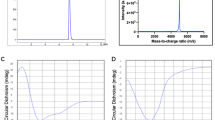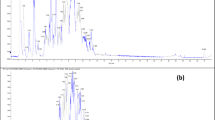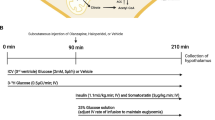Abstract
Although it is generally accepted that atypical antipsychotics differ in their risk for diabetic side effects, the underlying pharmacological mechanisms are unknown. Studies on the mechanisms of antipsychotic-induced hyperglycemia or insulin resistance are often confounded by the concomitant weight gain and dyslipidemia, known diabetic risk factors. To investigate whether antipsychotics can acutely cause metabolic effects before any change in body composition, we studied the effects of four atypical antipsychotics on whole-body insulin resistance. Using the hyperinsulinemic, euglycemic clamp technique in conscious rats, insulin and somatostatin were infused at a constant rate to provide constant hyperinsulinemia and to suppress pancreatic insulin secretion. Glucose was infused at a variable rate, adjusted to maintain euglycemia. At steady state, animals were administered vehicle (V) or antipsychotic and the glucose infusion rate was monitored as an index of insulin sensitivity. Clamp experiments using radiotracers and studies on glucose uptake into isolated skeletal muscle were conducted to differentiate between effects on hepatic glucose production (HGP) and on peripheral glucose uptake. Olanzapine (OLAN) and clozapine (CLOZ) acutely impaired whole-body insulin sensitivity in a dose-dependent manner (P<0.001 vs V), whereas ziprasidone and risperidone had no effect. CLOZ also induced profound insulin resistance after dosing 10 mg/kg/day for 5 days (P<0.05 vs V). Tracer studies indicated that acute changes mainly reflect increased HGP, consistent with the lack of effect on glucose uptake. OLAN and CLOZ can thus rapidly induce marked insulin resistance, which could contribute to the hyperglycemia and ketoacidosis reported for patients receiving those therapies.
Similar content being viewed by others
Log in or create a free account to read this content
Gain free access to this article, as well as selected content from this journal and more on nature.com
or
References
Ader M, Kim SP, Catalano KJ, Iount V, Hucking K, Richey JM et al (2005). Metabolic dysregulation with atypical antipsychotics occurs in the absence of underlying disease. A placebo-controlled study of olanzapine and risperidone in dogs. Diabetes 54: 862–871.
American Diabetes Association, American Psychiatric Association, American Association of Clinical Endocrinologists, North American Association for the Study of Obesity (2004). Consensus development conference on antipsychotic drugs and obesity and diabetes. Diabetes Care 27: 596–601.
Ardizzone TD, Bradley RJ, Freeman AM, Dwyer DS (2001). Inhibition of glucose transport in PC12 cells by the atypical antipsychotics drugs risperidone and clozapine, and structural analogs of clozapine. Brain Res 923: 82–90.
Balkan B, Dunning BE (1995). Muscarinic stimulation maintains in vivo insulin secretion in response to glucose after prolonged hyperglycemia. Am J Physiol 268: R475–R479.
Bergman RN, Ader M (2005). Atypical antipsychotics and glucose homeostasis. J Clin Psychol 66: 504–514.
Bergman RN, Hope ID, Yang YJ, Watanabe RM, Meador MA, Youn JH et al (1989). Assessment of insulin sensitivity in vivo: a critical review. Diabetes/Metab Rev 5: 411–429.
Bjornholm M, Zierath JR (2005). Insulin signal transduction in human skeletal muscle: identifying the defects in type 2 diabetes. Biochem Soc Trans 3: 354–357.
Bouche C, Serdy S, Kahn CR, Goldfine AB (2004). The cellular fate of glucose and its relevance in type 2 diabetes. Endocrine Rev 25: 807–830.
DeFronzo RA (2004). Pathogenesis of type 2 diabetes mellitus. Med Clin N Am 88: 787–835.
De Hert MA, Van Winkel R, Van Eyck D, Hanssens L, Wampers M, Scheen A et al (2006). Prevalence of the metabolic syndrome in patients with schizophrenia treated with antipsychotic medication. Schizophrenia Res 8: 87–93.
Deibert DC, DeFronzo RA (1980). Epinephrine-induced insulin resistance in man. J Clin Invest 65: 717–721.
Dwyer DS, Donohoe D (2003). Induction of hyperglycemia in mice with atypical antipsychotics drugs that inhibit glucose uptake. Pharm Biochem Behav 75: 255–260.
Dwyer DS, Lu X-H, Bradley RJ (2003). Cytotoxicity of conventional and atypical antipsychotic drugs in relation to glucose metabolism. Brain Res 971: 31–39.
Etgen Jr GJ, Fryburg DA, Gibbs EM (1997). Nitric oxide stimulates skeletal muscle glucose transport through a calcium/contraction- and phosphatidylinositol-3-kinase-independent pathway. Diabetes 46: 1915–1997.
Frost SC, Lane MD (1985). Evidence for the involvement of vicinal sulfhydryl groups in insulin-activated hexose transport by 3T3-L1 adipocytes. J Biol Chem 260: 2646–2652.
Gardemann A, Puschel G, Jungermann K (1992). Nervous control of liver metabolism and hemodynamics. Eur J Biochem 207: 399–411.
Henderson DC, Cagliero E, Copeland PM, Borba CP, Evins E, Hayden D et al (2005). Glucose metabolism in patients with schizophrenia treated with atypical antipsychotic agents: a frequently sampled intravenous glucose tolerance test and minimal model analysis. Arch Gen Psychiatry 62: 19–28.
Holt RIG, Pevert RC, Byrne CD (2004). Schizophrenia, the metabolic syndrome and diabetes. Diabetes UK Diabetic Med 21: 515–523.
Iguchi A, Gotoh M, Matsunaga H, Yatomi A, Honmura A, Yanase M et al (1988). Relative contributions of the nervous system and hormones to CNS-mediated hyperglycemia. Am J Phsyiol 255: E920–E927.
James DE, Burleigh KM, Kraegen EW (1986). In vivo glucose metabolism in individual tissues of the rat: interaction between epinephrine and insulin. J Biol Chem 261: 6366–6374.
Johnson DE, Nedza FM, Spracklin DK, Ward KM, Schmidt AW, Iredale PA et al (2005a). The role of muscarinic receptor antagonism in antipsychotic-induced hippocampal acetylcholine release. Eur J Pharmacol 506: 209–219.
Johnson DE, Yamazaki H, Ward KM, Schmidt AW, Lebel WS, Treadway JL et al (2005b). Inhibitory effects of antipsychotics on carbachol-enhanced insulin secretion from perfused rat islets. Role of muscarinic antagonism in antipsychotic-induced diabetes and hyperglycemia. Diabetes 54: 1552–1558.
Kapur S, Vanderspek SC, Brownlee BA, Nobrega JN (2003). Antipsychotic dosing in preclinical models is often unrepresentative of the clinical condition: a suggested solution based on in vivo occupancy. J Pharm Exp Ther 305: 625–631.
Koller EA, Doraiswamy PM (2002). Olanzapine-associated diabetes mellitus. Pharmacotherapy 22: 841–852.
Koller EA, Schneider B, Bennett K, Dubitsky G (2001). Clozapine-associated diabetes. Am J Med 111: 716–723.
Kraegen EW, James DE, Jenkins AB, Chisholm DJ (1985). Dose-response curves for in vivo insulin sensitivity in individual tissues in rats. Am J Physiol 248: E353–E362.
Lieberman JA, Scott Stroup T, McEvoy JP, Swartz MS, Rosenheck RA, Perkins DO et al (2005). Effectiveness of antipsychotic drugs in patients with chronic schizophrenia. N Engl J Med 353: 1209–1223.
McEvoy JP, Meyer JM, Goff DC, Nasrallah HA, Davis SM, Sullivan L et al (2005). Prevalence of the metabolic syndrome in patients with schizophrenia: baseline results from the Clinical Antipsychotic Trials of Intervention Effectiveness (CATIE) schizophrenia trial and comparison with national estimates from NHANES III B. Schizophrenia Res 80: 19–32.
Meyer JM, Nasrallah HA, McEvoy JP, Goff DC, Davis SM, Chakos M et al (2005). The Clinical Antipsychotic Trials of Intervention Effectiveness (CATIE) schizophrenia trial: clinical comparison of subgroups with and without the metabolic syndrome. Schizophrenia Res 80: 9–18.
Newcomer JW (2005). Second-generation (atypical) antipsychotics and metabolic effects—a comprehensive literature review. CNS Drugs 19 (Suppl 1): 1–93.
Newcomer JW, Haupt DW, Fucetola R, Melson AK, Schweiger JA, Cooper BP et al (2002). Abnormalities in glucose regulation during antipsychotic treatment of schizophrenia. Arch Gen Psychiatry 59: 337–345.
Nonogaki K, Iguchi A (1997). Role of central neural mechanisms in the regulation of hepatic glucose metabolism. Life Sciences 60: 797–807.
Robinson KA, Yacoub SZ, Buse MG (2006). At therapeutic concentrations, olanzapine does not affect basal or insulin-stimulated glucose transport in 3T3-L1 adipocytes. Prog Neuro-Psychopharm Biol Psychiatry 30: 93–98.
Rossetti L, Giaccari A, Barziliai N, Howard K, Sebel G, Hu M (1993). Mechanism by which hyperglycemia inhibits hepatic glucose production in conscious rats. J Clin Invest 92: 1126–1134.
Rossetti L, Smith D, Shulman GI, Papachristou D, DeFronzo RA (1987). Correction of hyperglycemia with phlorizin normalizes tissue sensitivity to insulin in diabetic rats. J Clin Invest 79: 1510–1515.
Sernyak MJ, Gulanski B, Resenheck R (2005). Undiagnosed hyperglycemia in patients treated with atypical antipsychotics. J Clin Psychiatry 66: 1463–1467.
Somogyi M (1945). Determination of blood sugar. J Biol Chem 160: 69–73.
Sowell M, Mukhopadhyay N, Cavazzoni P, Carlson C, Mudaliar S, Chinnapongse S et al (2003). Evaluation of insulin sensitivity in healthy volunteers treated with olanzapine, risperidone, or placebo: A prospective, randomized study using the two-step hyperinsulinemic, euglycemic clamp. J Clin Endocrinol Metab 88: 5875–5880.
Sowell MO, Mukhopadhyay N, Cavazzoni P, Shankar S, Steinberg HO, Breier A et al (2002). Hyperglycemic clamp assessment of insulin secretory responses in normal subjects treated with olanzapine, risperidone, or placebo. J Clin Endocrinol Metab 87: 2918–2923.
Vatamaniuk MZ, Horyn OV, Vatamaniuk OK, Doliba NM (2003). Acetylcholine affects rat liver metabolism via type 3 muscarinic receptors in hepatocytes. Life Sci 72: 1871–1882.
Acknowledgements
All authors of this work are employees of Pfizer Inc. Pfizer discovers, develops, and markets therapies to treat schizophrenia and diabetes.
Author information
Authors and Affiliations
Corresponding author
Additional information
A portion of the data from this study was presented in poster form at the Annual Meetings of the European and American Colleges of Neuropsychopharmacology (Amsterdam, 2005 and Hawaii, 2005) and the European Association for the Study of Diabetes (Athens, Greece, 2005).
Rights and permissions
About this article
Cite this article
Houseknecht, K., Robertson, A., Zavadoski, W. et al. Acute Effects of Atypical Antipsychotics on Whole-Body Insulin Resistance in Rats: Implications for Adverse Metabolic Effects. Neuropsychopharmacol 32, 289–297 (2007). https://doi.org/10.1038/sj.npp.1301209
Received:
Revised:
Accepted:
Published:
Issue date:
DOI: https://doi.org/10.1038/sj.npp.1301209
Keywords
This article is cited by
-
Depicting Risperidone Safety Profiles in Clinical Trials Across Different Diagnoses Using a Dopamine D2-Based Pharmacological Class Effect Query Defined by FAERS
Clinical Drug Investigation (2022)
-
Metformin for early comorbid glucose dysregulation and schizophrenia spectrum disorders: a pilot double-blind randomized clinical trial
Translational Psychiatry (2021)
-
Psychotische Störungen, Antipsychotika und Diabetes
Der Diabetologe (2021)
-
Exercise Protects Against Olanzapine-Induced Hyperglycemia in Male C57BL/6J Mice
Scientific Reports (2018)
-
The microbiome-gut-brain axis: implications for schizophrenia and antipsychotic induced weight gain
European Archives of Psychiatry and Clinical Neuroscience (2018)



